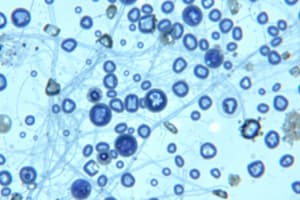Podcast
Questions and Answers
What is microscopy?
What is microscopy?
The technical field of using microscopes to view samples and objects that cannot be seen with the unaided eye.
What is micrometry?
What is micrometry?
A technique used to measure microscopic objects.
Which of the following parts is responsible for holding the specimen in place on a microscope?
Which of the following parts is responsible for holding the specimen in place on a microscope?
- Stage clips (correct)
- Fine adjustment knob
- Ocular lens
- Condenser
What happens to the image viewed through a microscope?
What happens to the image viewed through a microscope?
The calibration constant is calculated using the formula: (stage micrometer spaces / ocular micrometer spaces) × ____
The calibration constant is calculated using the formula: (stage micrometer spaces / ocular micrometer spaces) × ____
Ocular micrometers are always reliable for measurement.
Ocular micrometers are always reliable for measurement.
What causes hemolysis in red blood cells?
What causes hemolysis in red blood cells?
Which of the following solutions is isotonic for red blood cells?
Which of the following solutions is isotonic for red blood cells?
What is the internal condition of the membrane for active dry yeast when it is acidic?
What is the internal condition of the membrane for active dry yeast when it is acidic?
Heat denatures proteins, halting all living processes.
Heat denatures proteins, halting all living processes.
Diffusion involves the net movement of solute from an area of _____ concentration to an area of _____ concentration.
Diffusion involves the net movement of solute from an area of _____ concentration to an area of _____ concentration.
Study Notes
Microscopy and Micrometry
- Microscopy involves using microscopes to view small objects invisible to the naked eye.
- Micrometry measures microscopic objects through ocular micrometers calibrated with stage micrometers.
- Compound light microscopes utilize light and multiple lenses for specimen magnification.
Microscope Components
- Ocular Lens/Eyepiece: Magnifies the specimen for viewing.
- Body Tube: Connects the eyepiece to the revolving nosepiece.
- Revolving Nosepiece: Holds multiple objective lenses.
- Objective Lenses: Each lens magnifies the specimen.
- Arm: Supports the body tube and stage.
- Stage: Holds the specimen in place for viewing.
- Stage Clips: Secure the specimen on the stage.
- Light Source: Provides illumination from below; uses a light source, not a mirror.
- Condenser: Regulates light intensity reaching the specimen.
- Base: Provides stability and support for the microscope.
- Main Adjustment Knob: Used for rough focusing.
- Fine Adjustment Knob: Used for precise focusing.
Image Viewing and Calibration
- Images appear inverted due to the use of convex lenses.
- Calibration constant is calculated using stage micrometer and ocular micrometer measurements.
- Ocular micrometers are preferred for measurements; stage micrometers serve as a larger reference.
- Calibration quantifies the ocular micrometer's divisions for precise measurement.
- Length/width measurements depend on the calibration constant and number of ocular micrometer spaces.
- Linear magnification combines the powers of both ocular and objective lenses.
- Field of View (FOV) decreases as magnification increases; largest at low power objective (LPO).
Cell Structures and Functions
- Mitochondria are essential for cellular packing and sorting.
- Cytoplasm exists between the nucleus and cell membrane, with cytosol being its watery component.
- Protoplasm includes all living material within a cell, excluding the cell wall.
- Vacuoles are absent in plant cells while vesicles are present in animal cells.
Cellular Transport and Membrane Dynamics
- Plasma membrane structure is amphipathic, containing hydrophilic heads and hydrophobic tails.
- Staining effectiveness depends on charge interactions; oppositely charged molecules may not enter cells.
- Methylene blue allows for cell penetration once the outer membrane is lysed (broken down).
Selective Permeability of Plasma Membrane
- Congo red is a weak cationic dye that binds easily to anionic lysosomal sites.
- Active Dry Yeast (Saccharomyces cerevisiae) shows an internal acidic environment due to proton pumping.
- External environments remain basic; pumping out protons increases external alkalinity.
Conditions Affecting Selectivity
- Formalin (40%): Cross-links proteins, halting cellular processes and blocking protein channels.
- Heat: Causes denaturation and breakdown of proteins.
Diffusion and Factors Influencing It
- Diffusion involves the movement of solutes from high to low concentration.
- Collodion films allow for faster diffusion due to smaller particle size.
- Factors influencing diffusion rate include size (surface area) and polarity (hydrophobic nature repels polar molecules).
Osmosis and Cell Behavior
- Using Tradescantia spathacea to demonstrate osmotic behavior in varying solutions.
- Distilled water is hypotonic, leading to turgidity in plant cells.
- Concentrations of NaCl influence tonicity:
- 0.5% NaCl (isotonic/flaccid)
- 1.0% NaCl (hypertonic/plasmolyzed)
Hemolysis in Red Blood Cells
- Erythrocytes exhibit different responses to solutions:
- Distilled water is hypotonic, leading to lysis (cell rupture).
- 0.9% NaCl is isotonic, maintaining normal rbc shape.
- Higher concentrations (10% NaCl) are hypertonic, causing cell shrinkage.
Studying That Suits You
Use AI to generate personalized quizzes and flashcards to suit your learning preferences.
Related Documents
Description
This quiz covers essential concepts in microscopy and micrometry discussed during the post-lab session. It includes the use of microscopes, techniques for measuring microscopic objects, and the functions of different microscope parts. Test your understanding and retention of these key topics.




